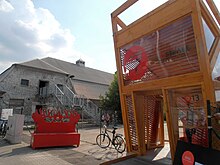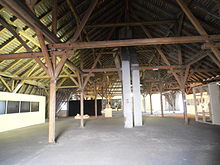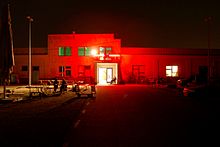OSTRALE - International Contemporary Art Exhibition
The OSTRALE - Center for Contemporary Art has been organizing an international exhibition for contemporary arts in Dresden since 2007 . Initially opened in an annual cycle, the Ostrale 2017 became a biennale and will take place again in 2019. The OSTRALE is aimed at an audience that is fundamentally interested in art and does not necessarily have to have experience with the classic concept of art.
Name and logo
The name OSTRALE is a combination of the words "Ostragehege" and "Signals". The former denotes the place of issue. The term “signals” provided the thematic framework for the first exhibition in 2007. The logo, a symbolized deer, refers to the location of the exhibition - the Ostragehege , a former hunting ground of the Saxon Elector, located on a peninsula near the center of Dresden.
history
At the beginning of 2007 the Dresden artists Andrea Hilger and Mike Salomon were looking for venues for the possibility of performing contemporary dance . After an inquiry with the city of Dresden , they were referred to the previously unused fallow land and the buildings of the former municipal cattle and slaughterhouse , which were exposed to decay . From the idea of using the rooms exclusively for dance performances, the curators developed a concept for use as a temporary, cross-genre exhibition for the visual and performing arts . The first OSTRALE took place in summer 2007.
On an exhibition area of over 20,000 m², young, not yet established artists were shown alongside internationally recognized artists who work in all artistic genres - from painting to photography and sculpture to dance and performance -, sound, light and video art - express.
The exhibition took place in changing buildings in the first few years. Many of the buildings used for the exhibition are now being used by others or are falling into disrepair. Until 2011, the city of Dresden, as the owner of the site, rented the buildings to the sponsoring association for the current year. In 2012, both sides signed a ten-year usage contract for the main exhibition rooms, the two listed and unrenovated former feeding stalls east and west. In 2013 the area was hit by floods . As a result, the subsoil sank, which led to structural damage to the feed stalls. This damage added to the existing renovation backlog. Neither the city of Dresden nor the Ostrale sponsoring association currently see themselves in a position to raise the necessary funding for the renovation of the buildings. Therefore the Ostrale team started a call for donations. The license to use, subject to certain conditions, was only valid until December 31, 2017. Ostrale eV therefore had to leave the premises.
Until 2012 the artists were able to participate based on their own application. That brought the Ostrale the charge of arbitrariness. For this reason, the changeover to a two-stage system took place in 2013: on the one hand, artists are invited by the organizers to participate, and on the other hand, artist applications are reviewed by a jury. The number of exhibiting artists fell to 86 in 2013. In 2014, around 200 artists from a total of 34 countries took part.
In 2017, the Ostrale was held as a biennale for the first time . The name was officially changed to '' OSTRALE-Biennale '' and has since been held as a purely invitation exhibition. In 2019, the O19 Biennale will take place from July to September. The historical tobacco factory f6 in Dresden- Striesen serves as the main exhibition site , accompanied by five satellite exhibitions in the city of Dresden
Artists, curators, visitors
| year | Visitors | Curator (s) |
|---|---|---|
| OSTRALE Biennale O19 | 28,000 | Drorit Gur Arie, Syowia Kyambi, Yik Chow, Toni Sant, Antka Hofmann, Andrea Hilger |
| OSTRALE Biennale O17 | 29,000 | Mykola Dzhychka, Oliver Kratz, Detlef Schweiger, Holger Wendland, Antka Hofmann, Andrea Hilger |
| OSTRALE O16 | 25,000 | Drorit Gur Arie, Risa Takita, Syowia Kyambi, Tomasz Wendland, Harro Schmidt, Antka Hofmann, Andrea Hilger |
| OSTRALE O15 | 20,000 | Lydeke Schakel, Sybille Nütt, Mirosław Jasiński, Harro Schmidt, Andrea Hilger |
| OSTRALE O14 | 19,000 | Nadine Bors, Andrea Hilger |
| OSTRALE O13 | 18,000 | Knut Hartwich, Friedrich Loock , Moritz Stange, Andrea Hilger |
| OSTRALE O12 | 17,500 | Martin Müller, Benjamin Fleig, Andrea Hilger |
| OSTRALE O11 | 17,000 | Martin Müller, Benjamin Fleig, Andrea Hilger |
| OSTRALE O10 | 16,000 | Martin Müller, Andrea Hilger |
| OSTRALE O9 | 11,000 | Andrea Hilger; Co-curators: Katja Albers, Martin Müller, Lukas Feireis |
| OSTRALE O8 | 6,500 | Sabine Zimmermann |
| OSTRALE O7 | 3,500 | Andrea Hilger, Mike Salomon |
The historic slaughterhouse area
The historic city cattle and slaughterhouse was built from 1906 to 1910 on a largely artificially raised area of the Ostragehege by the city building officer, Hans Erlwein, in the so-called Heimatschutzstil . The complex, which originally consisted of 68 buildings, gave the character of a village and was not only used to house and slaughter cattle, but was also equipped with market halls, an inn, residential and commercial buildings and a hotel. At that time the Erlweinsche Schlachthof was the largest and most modern slaughterhouse in Europe to date, which was characterized by its own rail connection, an autonomous energy supply and wastewater treatment. The bombing of Dresden on February 13, 1945 also caused severe damage to the slaughterhouse complex. Due to the acute food shortage in the post-war period, the building was rebuilt in a simplified style and, during the GDR, the Dresden meat combine, which was in operation until 1995, was housed here.
Exhibition locations
The OSTRALE exhibition locations were spread over the entire site of the former slaughterhouse until 2012 and were alternately used depending on the exhibition season and the curatorial concept. From 2013 to 2017 only the feeding stalls were used.
Feed stalls
The feeding stalls were used to feed the animals and store the hay in the attic.
The building complex consists of two parts: the feeding stall west and the feeding stall east. The stables each have two floors with a total of around 8000 m² of exhibition space. Entry through one of the eight gates (feeding stalls west) or ten gates (feeding stalls east), which divide the stalls into individual séparées . The hayloft in the attic can be reached via stairs and is used for exhibitions and events.
Fat melt
The former Fettschmelze was part of the VEB Dresdner Fleischkombinat until 1994 and was until recently a training center for the butcher's trade. Since then the building with a size of approx. 3000 square meters has been empty. The building was given its own distinctive interior through repeated renovation processes. All 40 rooms of the fat melt are different in size and structure.
Cold store
The artistic offices of OSTRALE are located in parts of the Frigolanda cold store. For the first time, former cooling chambers were used as an art space as part of OSTRALE'O11.
Exhibition foyer
In cooperation with Messe Dresden , opposite the site, the exhibition foyer is used as an art space.
Social wing
The social wing was used as an art and event area of the OSTRALE from 2007 to 2010 - but has since been sold by the City of Dresden. The social wing is no longer part of the exhibition grounds. Until 2010 it served as an event and production area, including catering and sanitary facilities, as well as workshops, workrooms and studios.
Pig hall
The pig hall was used as the OSTRALE's art space from 2007 to 2010. The pig hall is a more than 1300 m² hall in the center of the site. The ceiling lets generous light into the building through a large number of rows of windows. Pillars that protrude into the room create a vertical division of the room.
Porter's lodge
The gatekeeper used to control access to the site here. The smallest exhibition building at OSTRALE is right at the entrance to the slaughterhouse. As part of OSTRALE'O9, the porter's house was painted purple.
Donkey stall
The donkey stable is opposite the porter's house. This used to house the donkeys that pulled the loads across the eastern area. For the OSTRALE'O9 the facade of the house was gilded and used as a projection surface.
House 11
The building is located on the fallow land between the feeding stalls and the Frigolanda cold store and was used for the first time at OSTRALE'O12. In the past, technical systems were located there, mainly the electrical system and offices.
Accessibility
With the construction of the meadow ramp, OSTRALE has been paving the way for people with walking disabilities to the second level of the exhibition since 2014 . The barrier-free wooden construction that meanders across the site was created as a continuation of the cash desk built in 2013 under the direction of the Italian architect duo "albitalbero". Numerous regional and international workshops for the disabled, including those from Rothenburg , Radebeul and Liège in Belgium , contributed to the construction of the ramp as a project by people with handicaps for people with handicaps. Not only wheelchair users, but also families with prams use this ramp from the wooden bridge with the green verge.
Receptions
- Joachim Lange in Mitteldeutsche Zeitung (August 10, 2012): “But against Wagner and Co. in the Semper Opera House or the 500-year-old Sistine Madonna in the Zwinger , contemporaries in Dresden still have a hard time, unless they are Hans-Werner Henze or Gerhard Richter and have already achieved the status of a classic themselves. [...] The fact that Saxony's Art Minister Sabine von Schorlemer has now taken over the patronage [...] is also recognition of what has been achieved so far. "
- Carsten Probst in Deutschlandfunk (July 19, 2014): “The Ostrale is expanding more and more into Dresden's urban space, launching initiatives against right-wing radicalism and for the acceptance of young art, lots of construction sites where other art locations in Dresden have been grappling their teeth for decades. "
- Ramona Ackermann on CYNAL - New Art in Dialogue (August 3, 2014): “Whatever one might say about Berlin and Leipzig in terms of up-and-coming art metropolises - Dresden is not only in no way inferior to these trends, it proves [...] that it is anything but a sleepy city. Because a really fresh wind blows from here! "
- Birgit Grimm in Sächsische Zeitung (September 25, 2014): "The public wants the Ostrale, and Dresdeners need this show of international art."
Prices
- Art Prize of the State Capital Dresden 2009
- Nominated for the Dresden Tourism Prize 2012
Accompanying program
During the period of the exhibition there will be educational offers to introduce younger people and people with disabilities to contemporary art and their own artistic activity. More than 3500 pupils and teachers who visited the OSTRALE in 2014 alone prove the artistic and social reference to this historically and architecturally interesting place as a teaching topic. The aim of the OSTRALE is: to increasingly work on the development of sustainable art educational concepts and to work out "Education through art" as an annual focus. The supporting program “OSTRALE.xtra” includes contemporary forms of expression between the performing and visual arts and is intended to deal with the rooms and outdoor areas in a new way. Activities include performances, concerts, work-in-progress activities, lectures, workshops and panel discussions, including dance and theater performances and readings. The OSTRALE.xtra program expands the range of exhibitions to include perspectives and standpoints and offers aesthetic experiences for the senses.
Out of OSTRALE
After the end of the season on the Ostragehege exhibition grounds, a selection of the works has been shown as “Out of OSTRALE” in other European cities since 2010. The decision is made by a jury. The works should fit the newly chosen exhibition location and present the best works of the OSTRALE. In this way, some of the works are shown in different exhibition rooms over a period of one month, so that the OSTRALE is visible in Europe for five months. The previous Out-of-OSTRALE exhibition locations were Katowice (Poland) and Eupen (Belgium). In 2014 the University Hospital Dresden showed exhibits by selected OSTRALE artists in the out-of-OSTRALE exhibition “stayment”.
organization
The international exhibition for contemporary arts is organized by the sponsoring association OSTRALE eV and is financed by entrance fees, subsidies and sponsorship services. The non-profit association OSTRALE.freunde eV has been supporting the exhibition since April 2011. In addition to the artists, curators and gallery partners, around 80 to 85 people from the office team, technicians, craftsmen, construction and dismantling helpers, are involved in each issue of OSTRALE - and checkout staff.
Literature and Sources
- Joachim Lange: Art in the slaughterhouse . In: Mitteldeutsche Zeitung , August 10, 2012
- Carsten Probst: The charm of the improvised . In: Deutschlandfunk , July 19, 2014
- Ramona Ackermann: Dresden - the imaginative cultural capital of the East . In: Cynal , August 3, 2014
- Uwe Salzbrenner: Spaceman in the field In: Sächsische Zeitung
Web links
- OSTRALE website
- OSTRALE catalogs available digitally for the years 2010 to 2013 at SLUB Dresden, accessed on October 8, 2016
- OSTRALE'O14 catalog part 1: hay and part 2: feed stored as PDF files on Qucosa , accessed on October 8, 2016
- OSTRALE'O7 to OSTRALE'O16 on kunstaspekte.de , accessed on October 8, 2016
- Website of the Friends of OSTRALE , accessed on November 27, 2014
- Promotion Prize of the City of Dresden 2009 , accessed on August 16, 2015
Individual evidence
- ↑ Ostrale threatens to lose the Sächsische Zeitung domicile from June 13, 2016, accessed on October 7, 2016
- ↑ Ostrale call for help ( memento of the original from June 2, 2017 in the Internet Archive ) Info: The archive link has been inserted automatically and has not yet been checked. Please check the original and archive link according to the instructions and then remove this notice. , accessed October 7, 2016
- ↑ Article on the blog meinwortgarten by Lilli Vostry , accessed on October 7, 2016.
- ↑ Website of the organizer, accessed on June 6, 2019.
- ↑ City Archives, 1930







